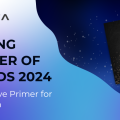The Barbie Movie: A Masterstroke of Marketing, Customer Loyalty, and Retail Strategy
Reading time: about 4 minutes

When Mattel announced the new Barbie movie, marketers watched with bated breath. A leap from toy manufacturing to the film industry is no small feat. Still, Mattel's gamble has paid off, with the film raking in an impressive $155 million domestically over its opening weekend and a staggering $337 million globally, earning the title of the highest-grossing debut 2023.
At its core, the Barbie movie is more than just a product. It's a narrative, telling a story about an iconic doll that transcends generations. Storytelling as a marketing tool must be considered - it commands attention, stirs emotions, and effectively drives customer loyalty. With a brand awareness of 99% worldwide, Barbie's story strikes a chord of nostalgia with older audiences while captivating the imagination of younger viewers.
This emotional connection was further leveraged by the creative and comprehensive marketing campaign put together by Warner Bros., who spared no expense in turning the movie into a global sensation. The estimated cost of this marketing extravaganza was around $150 million, excluding the production budget of $145 million. Their efforts ranged from partnerships resulting in products like a bright fuchsia Xbox to a $1,350 Balmain cropped hoodie, embedding Barbie into the lifestyle of their consumers.
Mattel tapped into this emotional connection, leveraging the movie as a potent marketing channel to foster deeper customer loyalty. The film ingeniously portrayed Barbie as a symbol of empowerment and possibility, reinforcing Mattel's branding and ethos. The movie's broad appeal was evident in its partnerships, with brands from all corners, like Crocs and Progressive Insurance's Flo, finding common ground in the color pink and Barbie's empowering narrative.
Retail marketing took center stage as the movie drove a surge in merchandise sales. The brilliance of this approach lies in its immersion - the Barbie movie transformed into a 1-hour 57-minute advertisement for the product line, amplifying the correlation between the film and retail sales. Children leaving the theater were predictably more likely to request the latest Barbie doll or accessory, driving a spike in retail sales.
Further cementing its marketing masterstroke, the Barbie movie paved the way for seamless omnichannel marketing. Mattel ingeniously connected the dots between the film, social media campaigns, in-store promotions, and online merchandise, creating a consistent and pervasive Barbie brand presence. This multifaceted approach ensured that Barbie was not just on a store shelf, but everywhere a potential customer could be.
The film also served as a platform for bolstering customer loyalty marketing. An immersive brand experience strengthened emotional connections with consumers, stimulated engagement, and encouraged repeat purchases. This approach led to a loyal customer base that saw value in investing in a brand experience rather than merely buying a product.
But Mattel's vision extended beyond immediate sales. The company took a long-term view by investing in future generations of customers. Children introduced to Barbie through the movie will likely develop into lifelong customers, carrying fond memories of the brand into adulthood. This long-term strategy underscores Mattel's intelligent understanding of lifecycle marketing.
Adding another layer to this marketing spectacle, the coinciding release of Barbie and Oppenheimer has birthed the intriguing 'Barbenheimer' phenomenon, a testament to the unique bonding power of cinema. This unlikely pair - the enchanting allure of the Barbie universe and the mesmerizing genius of Nolan's Oppenheimer - drew together an expansive, diverse audience. This coalition of fans from contrasting genres showcased the longing for the collective, immersive cinematic experience. This sentiment had lain dormant since the onset of the pandemic and the resultant shuttering of movie theaters. The simultaneous release acted as a beacon, a call to action for movie enthusiasts, successfully rekindling the thrill of the shared, in-theater experience and contributing to the revitalization of the film industry.
In conclusion, the new Barbie movie is more than just a cinematic success. It's a strategic marketing masterpiece that deftly blends storytelling, retail marketing techniques, and customer loyalty principles to maximize engagement and sales. With the box office figures as a testament, it is a classic example of how understanding your audience and effectively utilizing all available channels can craft a holistic marketing strategy that stands the test of time.
Regardless of your stance on Barbie, this innovative approach offers valuable insights for marketers aiming to boost their marketing acumen. After all, marketing isn't just about selling—crafting compelling stories that resonate with audiences and secure their loyalty.
- Author: Alexander Kubicki and Sparta Loyalty
- Entry Date: 28 07 2023





